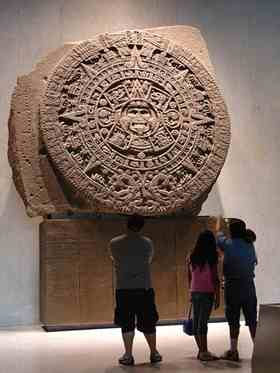In 1790, workers doing repairs in Mexico City unearth a massive stone bearing ancient symbols. It turns out to be a representation of the Aztec calendar and will eventually become a national treasure.
 The disc-shaped stone measured 12 feet in diameter and 3 feet thick. It was covered with pagan symbols. The Spanish had contemptuously buried it underneath the Zocalo, or central plaza of the city, soon after they toppled the Aztec empire in 1521. The new rulers also tore down the pagan grand temple and, at the opposite end of the plaza, built a large cathedral to worship their own deity.
The disc-shaped stone measured 12 feet in diameter and 3 feet thick. It was covered with pagan symbols. The Spanish had contemptuously buried it underneath the Zocalo, or central plaza of the city, soon after they toppled the Aztec empire in 1521. The new rulers also tore down the pagan grand temple and, at the opposite end of the plaza, built a large cathedral to worship their own deity.
Soon after its 1790 discovery, the 25-ton stone was again ritually subjugated to the new religion, this time by embedding it in the wall of the cathedral’s western tower.
When Mexico achieved independence from Spain in the early 19th century, it retained the Catholic religion but also developed a growing interest — and pride — in its indigenous history and culture. General Porfirio Diaz (nominally president, in reality a dictator) ordered the stone removed to the national Museum of Archaeology and History in 1885.
Though the stone carries calendrical and astronomical decoration, it’s now thought that it wasn’t used primarily to keep time, but as an altar for human sacrifice. Mexican anthropologists refer to it as the Cuauhxicalli Eagle Bowl or simply the Sun Stone — for the sun god Tonatuih, whose visage appears at the center.
Based on the earlier Mayan timekeeping, the Aztecs used two different types of year. A ritual calendar of 260 days rotated 20 divine symbols into a “week” with 13 numbered days. After 20 weeks, each sign (associated with a god) had appeared in each of the 13 slots, and the cycle was complete.
A secular, agricultural calendar kept pace with the seasons. It had 18 months of 20 days each. The month was divided into four market cycles (or “weeks”) of five days each. At the end of each year, an extra, monthless period of five unlucky days topped up the year to 365 days.
The new year of the two calendars coincided every 18,980 days, or once every 52 years. At that time, Aztec priests performed a special ritual to light a new fire in the bleeding chest of a sacrificial victim to ensure that, in their world view, the sun would not die. The 12-day New Fire rite was a period of abstinence marked by the destruction of old idols and the dousing of the ritual fires of the old cycle.
But the 12 days added to the calendar to conclude the cycle amounted to adding 12 leap days per 52 years. The Julian calendar then in use in Europe had a leap year every four years. The Gregorian calendar established in 1582 has 97 leap years in every 400. It turns out that the Aztec calculation of an average 365.2420 days per year is actually closer to the real value of 365.2422 days than the old Julian value of 365.2500 days or even our current Gregorian value of 365.2425 days.
The Sun Stone was hand-carved in the 52-year period from 1427 to 1479. Because the double calendar determined the timing of sacrifices, the sacrificial stone was decorated with calendar marking. A glyph on the outer rim marks the date 13-Reed, probably its creation date in the ritual calendar. Nearer the center, a circle of glyphs representing the 20 day names surrounds the face of the sun god.
When Mexico opened its modern, new National Museum of Anthropology in 1964, the Sun Stone was given the central place of honor among 120,000 works of artistic and cultural relevance. Two million visitors a year gaze upon it.
Author: Randy Alfred | Source: Wired [December 17, 2010]